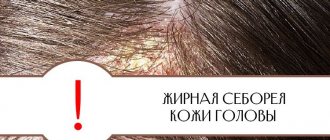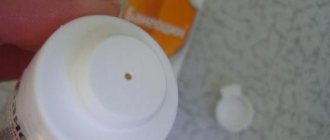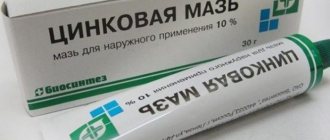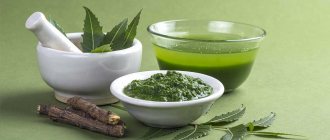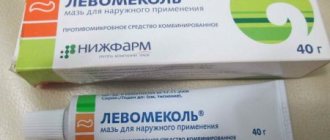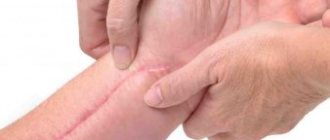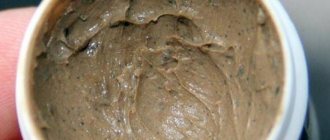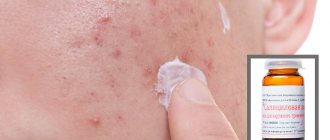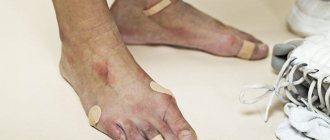Syntomycin ointment for burns has an analgesic and antibacterial effect on the injured area, helps to mitigate the course of painful symptoms and significantly accelerate the tissue healing process.
Composition and properties of the drug
The drug contains the active ingredient syntomycin, or chloramphenicol. This is an antibiotic that eliminates pathogenic microorganisms from burned skin and prevents their further reproduction. It is able to eliminate even such resistant strains of bacteria that local drugs containing penicillin cannot cope with.
This medication contains castor oil, which promotes:
- moisturizing the affected area;
- tissue restoration;
- eliminating redness, dryness and flaking of the burned area.
MP also contains a small amount of novocaine, which has an analgesic effect.
Excipients of the drug:
- emulsifiers;
- sorbic acid;
- carmellose sodium;
- purified water.
The ointment is a white or whitish-gray substance with almost no odor. The concentration of the drug can be from 1 to 10%.
Pharmacology
The pharmacological product provides a bacteriostatic effect, being, in fact, an antibiotic.
The principle of operation of the drug is based on disruption of protein reproduction in bacterial cells, which is achieved by inhibiting the activity of peptidyl transferase.
Chloramphenicol has a wide spectrum of action:
- exhibits activity against pathogenic microflora caused by gram-positive and gram-negative microorganisms;
- eliminates pathogens of staphylococci, Escherichia coli and Pseudomonas aeruginosa, Proteus, etc.;
- neutralizes the environment created by hospital strains of bacteria that are highly resistant to other antibiotics.
Is it possible to apply syntomycin ointment to a burn?
Burns are smeared with 10% Syntomycin ointment. The drug is used for 2nd and 3rd degree burns. For localized burns, the doctor prescribes comprehensive treatment so that the patient does not have scars. Bandages with Synthomycin ointment can be applied to any area of the skin except the face. An emulsion is used for facial skin.
When treating thermal damage to the skin, the ointment protects the affected area from the development of bacteria, infections, and the appearance of ulcers. An external application with an antibiotic softens the skin and removes necrotic tissue, thereby reducing the risk of scarring on the skin. To treat a burn, apply bandages with ointment, which are changed daily.
The drug must be prescribed by a doctor who draws up a treatment regimen, explains in detail how to use the drug, and determines the duration of the course of therapy. If severe pain occurs, the doctor prescribes additional painkillers and sedatives.
You cannot self-medicate, because... this can lead to dangerous consequences.
Types of diseases
There are the following types of lichen:
- shearer;
- pityriasis;
- encircling;
- pink;
- red, etc.
Treatment of fungal disease is possible with the help of special ointments for lichen. Their components can not only cope with the bacteria that caused the infection, but also restore the skin. There are a lot of these drugs, which allows you to choose the one you need that will cope well with a certain type of lichen. Each product works differently, so it is recommended to consult a dermatologist before use. We suggest you figure out which ointment to treat lichen in humans.
Use of this product for burn injuries
Syntomycin ointment should be used to treat grade 2 injuries when blisters appear. Doctors note the effectiveness of using the product for limited grade 3 injuries, when the deep layers of the skin are affected.
The drug is not prescribed for grade 1 lesions when the integrity of the skin is not compromised . There is no need to use an antibacterial drug such as Synthomycin ointment. Proper treatment promotes complete healing of the affected skin and prevents scarring.
With large burns, an inflammatory process develops and the skin becomes infected as a result of a decrease in the body's defenses. Syntomycin helps prevent the development of inflammation. To prevent complications when blisters appear, the ointment is applied immediately, without waiting for symptoms to worsen, pain to worsen, or swelling to increase. This approach promotes rapid healing of the epithelium, allows the skin to fully recover, and eliminates the appearance of scars.
For sunburn
Sunburn causes redness of the skin, blisters, and sometimes sores. Burns from exposure to ultraviolet rays can appear on the neck, back, face, shoulders, limbs and other areas of the body.
Synthomycin liniment can be used for sunburn of the 2nd degree, when blisters appear on the skin. The ointment is applied to a sterile gauze pad and applied to the affected area. Change the napkin once a day.
For burns with boiling water
If a burn occurs with boiling water or steam, blisters appear on the skin. If the lesion occupies a small surface, then therapy can be performed at home using Syntomycin ointment.
Burns from boiling oil may occur. Please note that the boiling point of oil is much higher than water. Therefore, when hot oil comes into contact with the skin, grade 2-3 damage immediately occurs.
Treatment of such skin damage can be carried out using ointment in the manner described above. If severe pain occurs, you need to take painkillers in the form of tablets. Treatment of the skin with ointment should be alternated with moisturizing cream, since the active ingredient of the drug dries the skin. Therapy continues for a week. If the symptoms do not decrease, then you should definitely consult a doctor.
"Sinaflan"
Sinaflan ointment is an excellent drug in the treatment of pityriasis rosea. In addition, it copes well with other types of lichen. It has antilichen active components that quickly neutralize pathogens. The ointment can be used to treat children over 2 years of age.
"Sinaflan" quickly relieves inflammatory processes caused by the fungus and promotes the restoration of affected epidermal cells. It is applied by spreading it evenly in a thin layer over the entire area of the lichen. The course of treatment lasts 7 days. There should be several courses. Their number is determined by the attending physician based on the degree of complexity of the disease.
"Sinaflan" relieves inflammation and restores skin
Use in pediatrics
The effect of the drug may have a negative effect when treating children under 1 year of age, since during therapy they may experience side effects such as:
- vomit;
- nausea;
- diarrhea;
- bloating.
Children from 1 to 3 years of age can use the medicine with caution only after prescription by a pediatrician and in a concentration of no more than 5%.
For children over 3 years of age, the drug is prescribed for burns, but caution must also be exercised.
Before treating the skin, the affected area is cleaned with Furacilin solution. Treatment should last no more than a week.
Possible side effects include:
- allergic reactions on the skin: rash, swelling, urticaria, dermatitis;
- disorders of the central and peripheral nervous system.
An overdose of the drug can provoke increased allergic reactions and cause anaphylactic shock. If negative manifestations occur after using the product, you should stop treatment and immediately contact your pediatrician.
Interaction
When Synthomycin is used simultaneously with some pharmacological products, a neutralizing effect is observed, which negates the treatment.
Such means include:
- Clindamycin;
- Erythromycin;
- Lincomycin.
When selecting medications for a comprehensive solution to the problem, it is important to take into account that cephalosporins and penicillins lose their antibacterial properties in combination with chloramphenicol.
Side effects and contraindications
The ointment is a safe, effective treatment for burns, but it should be used with caution, following these rules:
- Do not apply to the affected skin more often than indicated in the instructions, because it may cause an allergic reaction;
- the duration of treatment is determined by the doctor;
- if you use the ointment for too long, it can lead to complications, so if long-term treatment is necessary, it is better to replace the drug with another remedy, for example, Zinc ointment.
Contraindications for treating burns with ointment:
- kidney dysfunction;
- liver dysfunction;
- eczema;
- severe burns over a large surface of the skin;
- malignant or benign tumors on the skin;
- animal bites;
- intolerance to the components of the drug.
If the product is used incorrectly, adverse reactions may occur such as:
- skin irritation;
- redness;
- itching;
- burning;
- chills;
- increase in body temperature.
The drug should not be used in combination with barbiturates, cytostatics, biphenyl, pyrazolone, or sulfonamides.
If adverse reactions occur, stop drug therapy and contact your doctor to reduce the dose or prescribe another drug.
"Sintomycin"
Syntomycin ointment copes very well with lichen diseases of the fungal type. It not only has anti-inflammatory and antibacterial properties, but also relieves unpleasant pain during the treatment of lichen. The advantage of the ointment is that it can be used even during pregnancy and breastfeeding. But it is worth remembering that before treatment you should definitely consult a dermatologist. If you use the drug for too long, its effect will decrease and there is a risk of irritation.
Features of applying the product
Let's consider how to apply this medicine for burns.
Instructions for use indicate the following:
- Rinse the burned area with cold running water to cool the burn.
- Carefully, trying not to touch the affected surface, remove remnants of clothing and jewelry, and then wash off any existing contaminants from the surface with running clean water.
- Treat the area with a weak solution of potassium permanganate or some other disinfectant composition, for example, furatsilin.
- Liniment is applied to a gauze bandage.
- Apply a gauze bandage treated with the product to the burn and tie it with a bandage.
- Bandages should be changed once a day.
- The duration of treatment is prescribed by the attending physician and should not exceed 7-10 days.
The effectiveness of the ointment should be observed 2-3 days from the start of using Syntomycin ointment. If there is no improvement, and inflammation of the affected area begins, pus forms, pain intensifies, swelling and redness increase, then you need to consult a doctor to adjust the treatment.
"Qicunbaxuan"
Qitsunba xuan has excellent qualities in the fight against lichen infection. The ointment relieves inflammation and discomfort that arises with the onset of the disease, helps restore the epidermis and improve blood supply. In addition to lichen, the drug copes well with psoriasis, eczema and dermatitis.
Mode of application
Before applying the ointment, the affected area of skin must be cleaned of scaly formations and rinsed. Treat the dried part with an antiseptic and apply the substance to the fungus, spreading it in an equal, thin layer over the surface. The procedure is carried out in the morning and evening. The duration of treatment depends on the complexity of the disease, so it is individual for everyone.
Contraindications
Qitsunbaxuan ointment should not be used during pregnancy and breastfeeding. Do not use the drug if the patient is allergic to its components.
"Qitsunbasyuan" - a specialized ointment for lichen
Cream for toenail fungus
Nail fungus more often affects the feet than the hands. This is due to the fact that our feet are often at risk due to favorable conditions for the development of bacteria. Let's dispel a few myths about the spread of toenail fungus.
- Myths and truth about nail fungus and treatment with creams
- Ointments: is it necessary to treat and is it possible to cope with only ointments?
- How to properly treat with ointments
- How to choose an ointment
- How ointments work
- Mikospor ointment for the treatment of nail fungus Get a detailed answer in a similar material:
Myths and truth about nail fungus and treatment with creams
At the slightest suspicion, we strongly recommend that you immediately go to the doctor
Myth 1. If you touch a person who is infected with a fungus, you will immediately catch the same disease.
No, not necessarily. Remember how much time you spent on the sand of the beaches, how much you swam with strangers in the same water. And most importantly, how often do you pick up money or touch handrails in transport. But all this also affected people who suffer from fungus on their fingernails or toenails. Are you infected? Or do infections happen less often? This is due to the fact that the fungus does not always take root on the nails of a healthy person.
Myth 2. The fungus will go away on its own.
Much depends on the type of fungus and the characteristics of the body’s protective functions, but in 95% of cases the fungus does not go away, especially on the legs. The sooner you start treatment, the better. And in this case, creams become effective in the fight (in the early stages).
Myth 3. The fungus is transmitted through touch.
This is partly true, but quite rarely you can become infected simply by touching an area of human skin or an object where mushrooms were left. Typically, infection occurs through thinned or damaged skin (abrasions, scratches, even microcracks). Therefore, unless you are injured, you are unlikely to get the fungus.
Myth 4. The condition of your nails has no effect on the likelihood of infection.
No, it is the condition of the nails, along with the state of the immune system, that plays an important role in the likelihood of becoming infected. If you have onycholysis (sagging of the nail plate from the skin), this will be an excellent condition for the development of fungi. Dirt will accumulate under the nail, and the mushrooms will definitely take advantage of this. Also, the ideal habitat for fungi is constantly wet feet. Take care of your feet, get a pedicure, change your socks on time and the likelihood of contracting a fungus will be minimized.
Myth 5. Toenail fungus cannot be treated - you need to remove the nail.
And this can be heard. No, even the most advanced fungus can be cured without resorting to such drastic decisions. Treatment often occurs with creams, but if more than three nails on one foot or more than half of the nail of one finger are affected, then creams will have to be combined with tablets. Sprays, varnishes and other products are also offered.
Ointments: is it necessary to treat and is it possible to cope with only ointments?
The ointment will help only at the first stage; experience shows that many people notice the fungus when it has already penetrated deeply into the nail plate
Yes, if, again, less than half of the nail is affected or the lesion affects no more than three nails on one foot, the ointment will be enough. If not, the ointment will also come in handy, you can’t do without it, but it’s definitely better to combine it with medications. Complex therapy should give results.
If you notice that the following symptoms appear on your nails, you need to consult a dermatologist:
- change in nail color (may even be greenish, so any change needs to be assessed);
- furrows appeared, the nail became uneven, with stripes;
- the nail curls;
- crumbles;
- there is an unpleasant odor;
- the nail becomes thicker;
- the nail becomes difficult to cut.
The doctor will then order tests for you. Laboratory tests will determine whether you have fungus. Remember, the symptoms often coincide with other ailments, or with a banal lack of vitamins.
Important!
Do not apply nail polish for a long time. Fungus can develop throughout the nail plate within a month. The period of development depends on the characteristics of the type of disease. Typically, two weeks pass from the day of infection to the appearance of the first symptoms.
When you receive the test results, the doctor will prescribe treatment. Remember, if you are scheduled for surgical removal of the nail, the matrix may be damaged during the procedure. Removing the nail is the most extreme measure.
With the help of ointment it is possible to cope with the fungus. Next we will look at how this can be done, since, unfortunately, in medical institutions, especially in government institutions, many details are often missed, and this is important in treatment.
How to properly treat with ointments
We recommend steaming your nails before use.
It is important to carry out treatment correctly. Toenail fungus can be difficult to treat, which sometimes takes about 8-10 months. This is due, first of all, to slow straightening of toenails, as well as the following features:
- Most of the year, your feet are in socks. A warm and humid environment encourages the development of fungus.
- People often experience discomfort in their feet from wearing uncomfortable shoes. It is usually narrow in the fingers. This causes the nail plate to become deformed, causing a pocket to form between the skin and the nail.
- People often place swimming pools and beaches as public places where the fungus can be re-contaminated immediately after completing drug therapy.
Treatment should occur in the following sequence when it comes to therapy with ointments:
- We buy everything you need. In addition to the ointment itself, you will need wire cutters, a file (possibly medical), and cotton pads. Remember, nails infected with fungus require separate tools that you will not use on healthy nails. The cheapest nippers will do.
- Before applying the ointment, prepare your nail well. Regardless of the location of the lesion, remove the free edge. It will need to be cut off gradually until the diseased nail grows completely.
- Take a specially prepared file, which, by the way, should also be left only for the duration of therapy and only for the affected nails. Use a file to process the nail evenly, removing the top layer. If this is not done, the drug will not get inside the nail, which means the treatment will be ineffective. This is the main problem of people who are prescribed treatment with ointments, solutions and other means for external use. Doctors do not tell you to remove the protective layer of the nail before using the ointment, which is why the person does not even understand why the drug did not help him.
- After preparing the nail, take a cotton pad and apply ointment to it. You can carry out this procedure without cotton, doing all the manipulations with your fingers, but using a cotton pad is more effective. Why? Because it is better to rub the ointment into the nail. With the help of cotton wool, the ointment better gets under the scales of the nail that make it up. For this we needed a file - with it we not only remove the protective gloss, but also lift the scales up so that the drug goes as deep as possible. The deeper it gets, the faster and more pathogens it will kill.
Perhaps that's all. Most often, two such procedures are required per day - in the morning and in the evening.
How to choose an ointment
The ointment should be selected based on the results of laboratory tests. The ointment is prescribed only by the attending physician (mostly dermatologists deal with such issues).
The fact is that all types of fungi are different. Ointments are also not universal - some ointments fight yeast, dermatophytes, molds and other types.
How ointments work
The ointment acts on the fungus as follows: the active components, depending on the drug and the type of fungus, enter the nail structure. In order for the ointment to be “absorbed” more deeply, it is better to make the nail less thick, that is, remove the thickness by filing it off with a file. You just need to do this carefully to avoid overdrinking and, as a result, injury.
So, the components of the ointment get inside. There they inhibit the work of fungal microorganisms, destroying them from the inside. Thus, with stable use of the ointment, you can be completely cured.
Mikospor ointment for the treatment of nail fungus
Contents of the Mycospor cream package
Mycospor is an antimycotic agent that quite effectively fights a number of pathogenic microorganisms.
The advantage of the drug Mikospor is an excellent alternative to expensive products. The price-quality ratio is optimal.
The active substance is bifonazole. Treatment can be aimed at the following types of fungus:
- yeast;
- gram-positive cocci;
- mold fungi.
The drug not only blocks the action of pathogens, but also prevents their reproduction.
What is included in the Mikospor kit:
- the ointment itself;
- scraper (as the manufacturer calls the file);
- dispenser;
- 15 patches.
Why are patches included in the kit? These are not the plasters that the vast majority of ordinary people are used to. The plaster is medical, it is glued to the nail not to protect it, but to soften it. In some cases, it is impossible to trim your nails yourself when they are affected by toenail fungus. Therefore, they are softened using a patch.
Contraindications for the drug Mikospor: only individual intolerance, that is, an allergy to the components, but this occurs very rarely.
Treatment lasts at least a month, but most often it is longer. There are practically no side effects, since the drug is not toxic to the body.
Analogs
If after 5-7 days of using liniment there is no positive dynamics of therapy, or for a number of reasons it is not possible to use Syntomycin, a substitute is selected.
Among the effective analogues, the composition of which is developed on the basis of an identical active substance:
A specific drug is suitable for each individual case. Only a qualified specialist can make a competent appointment.
Self-medication can not only negate the therapeutic effect, but also provoke a serious complication.
Impetigo
A fairly common disease is pyoderma or streptoderma (also known as impetigo). This is a very contagious skin disease, which is still more typical for people with poor personal hygiene. Through microcuts, cracks and scratches, streptococci or staphylococci enter the skin and begin to rapidly multiply, causing the appearance of painful blisters filled with liquid. When they open, they immediately infect adjacent areas of the skin. Syntomycin ointment is applied to the crusts that have formed at the site of the opened blisters, and thus prevents further spread of the infection and speeds up the process of getting rid of the infection.
